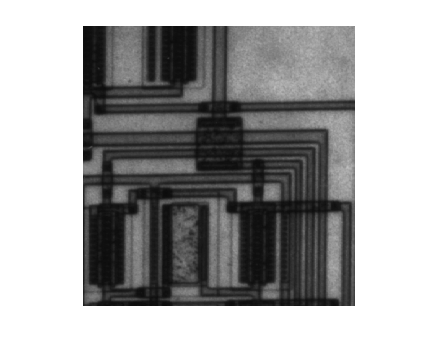graycomatrix
从图像创建灰度共生矩阵
说明
glcm = graycomatrix(I,Name=Value)Offsets 名称-值参量为一个图像创建多个 GLCM。
示例
输入参数
名称-值参数
输出参量
算法
graycomatrix 根据缩放后的图像计算 GLCM。默认情况下,如果 I 是二值图像,则 graycomatrix 将图像缩放到两个灰度级。如果 I 是灰度图像,则 graycomatrix 将图像缩放到八个灰度级。您可以通过使用 NumLevels 名称-值参量来指定 graycomatrix 用于缩放图像的灰度级的数量。您可以使用 GrayLimits 名称-值参量来调整 graycomatrix 缩放值的方式。
下图显示 graycomatrix 如何使用 [0 1] 的默认偏移量计算 GLCM 中的前三个值。在 GLCM 中,元素 (1, 1) 包含值 1,因为输入图像中两个水平相邻像素分别具有值 1 和 1 的情形只有一处。GLCM 中的元素 (1, 2) 包含值 2,因为两个水平相邻像素具有值 1 和 2 的情形有两处。GLCM 中的元素 (1, 3) 的值为 0,因为不存在两个水平相邻像素的值分别为 1 和 3 的情况。graycomatrix 继续处理输入图像,扫描图像中的其他像素对组 (i, j) 并将计数记录在 GLCM 的对应元素中。
如果像素对组中有任一像素包含 NaN,则 graycomatrix 忽略该像素对组,并用值 NumLevels 替换正的 Infs,用值 1 替换负的 Infs。如果对应的相邻像素位于图像边界之外,则 graycomatrix 忽略边界像素。
当 Symmetric 设置为 true 时创建的 GLCM 是关于其对角线对称的,等效于 Haralick (1973) 描述的 GLCM。在 Symmetric 设置为 true 时由以下语法生成的 GLCM
graycomatrix(I,Offset=[0 1],Symmetric=true)
等效于在 Symmetric 设置为 false 时由以下语句生成的两个 GLCM 的总和。
graycomatrix(I,Offset=[0 1],Symmetric=false) graycomatrix(I,Offset=[0 -1],Symmetric=false)
参考
[1] Haralick, R. M., K. Shanmugan, and I. Dinstein, "Textural Features for Image Classification", IEEE Transactions on Systems, Man, and Cybernetics, Vol. SMC-3, 1973, pp. 610-621.
[2] Haralick, R. M., and L. G. Shapiro. Computer and Robot Vision: Vol. 1, Addison-Wesley, 1992, p. 459.
版本历史记录
在 R2006a 之前推出




